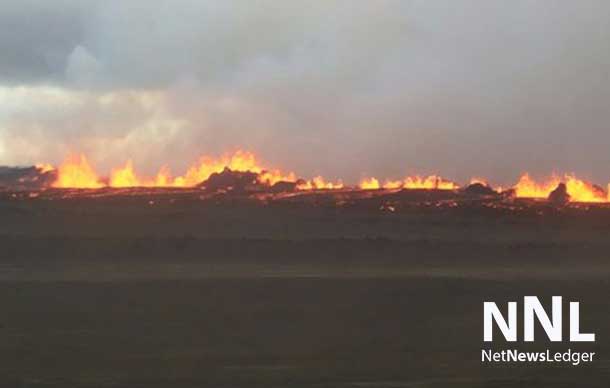Bárðarbunga Still Erupting
Veðurstofa Íslands – ENVIRONMENT – Concerns over the Bárðarbunga volcano in Iceland continue. The eruptions are continuing, and there are some who remain concerned over the danger from the volcano.
The Iceland Met Offices states, “Bárðarbunga, the second highest mountain of Iceland; ca 2000 meters above sea-level, is one of them. The volcano is placed in northwestern Vatnajökull ice cap and therefore covered with ice.”
Over the past weeks, as the volcano has started spewing lava, it has raised concerns that it could disrupt aviation. So far that has not been the case however.
Scientists from the Icelandic Met Office and the Institute of Earth Sciences and representatives of the Civil Protection in Iceland attend the meetings of the Scientific Advisory Board of the Icelandic Civil Protection. Representative from The Environment Agency of Iceland and the Chief Epidemiologist and the Directorate of Health, were also present.

Conclusions of the Scientific Advisory Board of the Icelandic Civil Protection:
- The eruptive activity at Holuhraun and the the subsidence of the Bárðarbunga caldera floor continues at similar intensity.
- The subsidence of the Bárðarbunga caldera and seismic activity continues the same as the last few days. The GPS station on top of Bárðarbunga shows a subsidence of the caldera around half a meter over the last 24 hours.
- The volcanic eruption in Holuhraun is still ongoing with similar strength as last few days. Lava flows at similar rates as yesterday towards East into Jökulsá á Fjöllum.
- The lava filed was measured yesterday afternoon to be 24,5 square kilometres.
- Accumulated volume of the lava is now estimated to be at least 200 million cubic meters.
- Gas cloud from the eruption drifts to the east. High level of SO2, sulphur dioxide, was measured at Reyðarfjörður last night around 10:00 o’clock. The highest value measured were just under 4000 micrograms per cubic meter. These are the highest values measured in Iceland. High level, 685 micrograms per cubic meter, was also measured in Egilsstaðir.
- Warning was sent via the GSM system to all mobile phones in Fjarðarbyggð.
- Air quality in urban areas in the East of Iceland:
-
- Forecasts indicate that high concentrations of sulphuric gases may be expected in the northern part of the Eastern fjords, Fljótsdalur, Hérað, Jökuldalur, and on Langanes. Forecast indicates that concentration may become higher later today. The Environment Agency will set up new monitoring stations in Akureyri and in South Iceland. Geographical conditions must be considered when estimating air quality.
- Instructions:
-
- People who feel discomfort are advised to stay indoors, close the windows, turn up the heat and turn off air conditioning. Use periods of good air quality to ventilate the house. Measurements of air quality can be found on a map from the Environment Agency. TheIcelandic Met Office issues text forecasts and warnings in header if conditions change to the worse.
- Some advise from The Environment Agency can be found on their web-site.
- The Icelandic Met Office will read forecasts for sulphuric gases along with weather news on the national radio and TV.
- The Environment Agency is working on getting more measuring equipment to better monitor the gases coming from the volcanic eruption.
- Air quality at the eruption site:
-
- Gas emissions at the eruption site remain high. As local gas concentrations at the site can be life threatening, people at the eruption site should wear gas masks and gas meters. At the eruption site, local wind anomalies can occur due to thermal convection from the hot lava. This makes the conditions on site extremely dangerous as winds can change suddenly and unpredictably. Scientists in the field carry gas meters for their security.
- Degassing from the volcanic eruption is now estimated to be up to 750 kg/sec.
- Three scenarios are considered most likely:
-
- Subsidence of the Bárðarbunga caldera stops and the eruption on Holuhraun declines gradually.
- Large-scale subsidence of the caldera occurs, prolonging or strengthening the eruption on Holuhraun. In this situation, it is likely that the eruptive fissure would lengthen southwards under Dyngjujökull, resulting in a jökulhlaup and an ash-producing eruption. It is also possible that eruptive fissures could develop in another location under the glacier.
- Large-scale subsidence of the caldera occurs, causing an eruption at the edge of the caldera. Such an eruption would melt large quantities of ice, leading to a major jökulhlaup, accompanied by ashfall.
- Other scenarios cannot be excluded.
History of the Bárðarbunga Volcano
The enormous size and nature of Bárðarbunga was not fully recognized until it was observed in 1973 on an image from a satellite, 800 km above Earth (see below). A caldera in the volcano’s crown, 11 km long on the longer side, is covered with approximately 850 m thick glacial ice. Eruptions related to the central volcano can occur anywhere in the caldera, on the sides of the volcano and also in the fissure swarms to the NA and SW of the volcano, for a distance up to 100 km from the central volcano.
Inevitably, immense eruptions and explosive eruptions are a possibility in the system with imminent threat of ice melting in great magnitude causing a huge jökulhlaup (glacial outburst flood). It is presumed that Jökulsárgljúfur and Ásbyrgi (see NLSI leita) were created in such cataclysmic events in prehistoric times. Large jökulhlaup in Kelduhverfi in the 17th century are believed to be related to volcanic activity in Bárðarbunga. (Source: Iceland Met Office)
